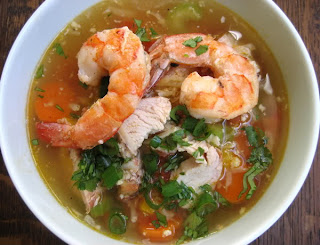Even though a fryer lives in our pantry, we don't bother. With techniques that are simple and are sure to produce perfect results each time...just make sure to lock the front door so you don't have neighbors following their noses into your kitchen!
Ingredients:
• 1 Tub of Crisco - (It was OK for Grandma... so it's ok for us, you can substitute a healthier alternative if you wish)
• Chicken - (We typically fry 10-12 pieces at a time, although you can use more or less, but you might need to adjust your oil level)
• 4 cups Rice Flour or AP Flour or Self-Rising Flour
• 3 Eggs
• 1/2 cup Water or Milk
• Salt, Pepper and Hot Sauce To Taste
• Paper Towels
Prepping The Chicken
Scrub and clean your kitchen sink. If you're doing a smaller amount of chicken, a large stock pot will work just fine, but we (as well as Grandma) are big believers in not dirtying a dish that we don't have to. Fill 1/2-3/4 of the way with cold water. We've even gone as far as to put ice cubes in. The cold will shock your chicken and help keep some of the juices in during the frying process. Start with room temperature chicken and allow to sit while you set up the dredging stations.
While chicken is taking a swim in its ice bath, add Crisco to a high sided pan and bring to 350 degrees. Now, Grandma uses an electric skillet and we've never been able to justify something we're pretty sure we'd only use for fried chicken, so we use a large skillet with 4" sides. We've also used stock pots, cast iron and Dutch oven style pots. So use what you have, even if that means using a sauce pan and frying one piece at a time! The amount needed will depend on the pan used. The ultimate goal is to have the oil come half way up your thickest piece of chicken. We typically put in 1/2 the container and go from there!
Lay two plates or baking dishes on the counter. Add flour to one (no need to season, it will come off during the frying process), and crack the eggs onto the other. Whisk eggs with a fork and add in water.
Take a piece of chicken out of the ice bath and shake it off and pat dry with a paper towel (we never actually use the towel, but Grandma did!). Lay it into the flour to cover, shake, and then drag it through the milk-egg mixture. Let any extra egg/milk mixture drain and place it back into the flour plate.
At this point in time, Grandma did all of her flouring and egging. She kept the chicken in a single layer on a separate plate while she completed the process. She always said it didn't have to be messier than it already was and we've since appreciated not having to worry about having one wet hand and one dry hand like other recipes tell you to do. Wash hands. Wash sink.
Frying The Chicken
Using tongs, place chicken into oil one piece at a time. Lay chicken in away from you just in case a splash occurs. Remember it isn't a race and crowding the pan isn't your friend. A good rule of thumb is to have at least an inch between all pieces of chicken in the pot. You need to be able to turn them without disturbing the other pieces!
Cover pan. Set timer for 6 minutes. Don't peek, don't sweat it... it will be ok. After 5 minutes, check the first piece of chicken added to the pot. Usually we find that an additional 2-3 minutes is ideal but checking at the 5 minute mark means no one's getting too crispy without your approval first. You want a goldeny-brown "typical" fried chicken color. Once that's achieved, flip the pieces over and salt and pepper the freshly fried side. It must be done quickly before the grease on top of the piece cools or dries. Do keep in mind each piece will darken slightly once it's out of the pan due to residual heat. Do not re-lid the pot after flipping chicken to the second side.
If after cooking on both sides the chicken isn't dark enough, you may continue flipping, but the longer it sits in the grease, the greasier it will be! So adjust your temperature or time as needed to try to cook only once on each side. 8 minutes per side is usually great.
Remove chicken from pan and place on paper towels. Even though our kitchens are trying to be more eco-friendly and paper towel-less, we still haven't found a good way around this step. We tried a drying rack, but it didn't wick extra grease out of the chicken the way the paper towels do.
Let cool and check internal temps if you have a concern about pieces being done all the way through, although after your first few pieces, you're sure to be able to eyeball when it's done.
After the meal has been put away, allow the Crisco to cool completely and remove it from the pan with a wooden spoon. The container it came in is a great vessel if it's headed to the trash!











